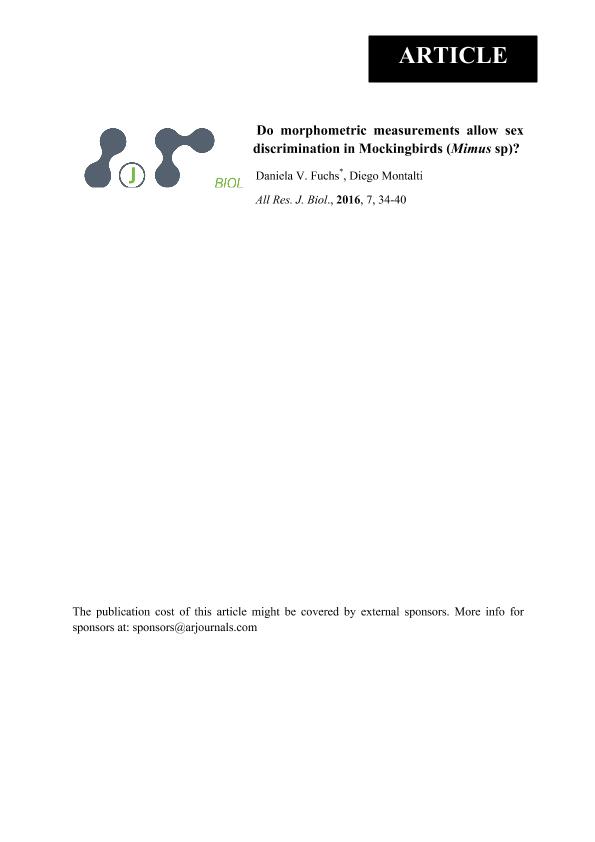Mostrar el registro sencillo del ítem
dc.contributor.author
Fuchs, Daniela Viviana

dc.contributor.author
Montalti, Diego

dc.date.available
2018-08-14T14:19:16Z
dc.date.issued
2016-10
dc.identifier.citation
Fuchs, Daniela Viviana; Montalti, Diego; Do morphometric measurements allow sex discrimination in Mockingbirds (Mimus sp)?; Society for the Improvement of Science; The All Results Journals: Biol; 7; 3; 10-2016; 34-40
dc.identifier.issn
2172-4784
dc.identifier.uri
http://hdl.handle.net/11336/55335
dc.description.abstract
Sexual dimorphism in birds may be expressed as differences in body size, plumage, color and/or behavior. Many species are monomorphic in color, making sex determination difficult in the field. An example of the latter are mockingbirds, which are passerines of the genus Mimus, endemic to the Americas. In order to distinguish between male and female mockingbirds using external body measurements that are easy to take, the objective of this work was to quantify morphometric differences between sexes in adults of the following species: M. thenca (45 specimens), M. patagonicus (95), M. saturninus (88), M. triurus (152), and M. dorsalis (7). We measured the following variables: culmen length, bill height and width, tarsus length, middle toe length, wing chord and tail length. Measurements were generally larger in males than in females except for bill width in M. saturninus and M. triurus, culmen length in M. thenca and M. dorsalis, and bill height in M. dorsalis. There were significant differences between sexes in wing chord for M. patagonicus, M. saturninus and M. triurus; tail length for M. patagonicus and M. triurus; tarsus length for M. patagonicus; and in middle toe length for M. triurus. No significant differences in measurements were found between sexes for M. thenca. Significant discriminant functions were obtained for M. patagonicus, M. saturninus and M. triurus, with a percentage of correct classification less than 80%. Only a few variables were useful for sex determination in the studied Mimus species, i.e. wing chord, tail length, middle toe length and tarsus length for three, two, one and one species, respectively.
dc.format
application/pdf
dc.language.iso
eng
dc.publisher
Society for the Improvement of Science
dc.rights
info:eu-repo/semantics/openAccess
dc.rights.uri
https://creativecommons.org/licenses/by-nc-sa/2.5/ar/
dc.subject
Mimidae
dc.subject
Mockingbirds
dc.subject
Morphometrics
dc.subject
Dimorphism
dc.subject
Southern South America
dc.subject.classification
Otras Ciencias Biológicas

dc.subject.classification
Ciencias Biológicas

dc.subject.classification
CIENCIAS NATURALES Y EXACTAS

dc.title
Do morphometric measurements allow sex discrimination in Mockingbirds (Mimus sp)?
dc.type
info:eu-repo/semantics/article
dc.type
info:ar-repo/semantics/artículo
dc.type
info:eu-repo/semantics/publishedVersion
dc.date.updated
2018-08-09T15:21:59Z
dc.journal.volume
7
dc.journal.number
3
dc.journal.pagination
34-40
dc.journal.pais
España

dc.journal.ciudad
Alcala de Guadaira
dc.description.fil
Fil: Fuchs, Daniela Viviana. Consejo Nacional de Investigaciones Científicas y Técnicas; Argentina. Centro de Investigaciones Científicas y Transferencia de Tecnología a la Producción; Argentina
dc.description.fil
Fil: Montalti, Diego. Consejo Nacional de Investigaciones Científicas y Técnicas; Argentina. Universidad Nacional de La Plata. Facultad de Ciencias Naturales y Museo. Departamento Científico Zoología Vertebrados; Argentina
dc.journal.title
The All Results Journals: Biol
dc.relation.alternativeid
info:eu-repo/semantics/altIdentifier/url/http://arjournals.com/index.php/Biol/article/view/133
Archivos asociados
